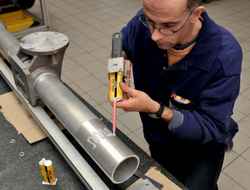
Posted to News on 12th Feb 2014, 12:26
Structural bonding for lighter-weight, energy efficiency robots
The use of composite materials can significantly reduce the weight of a product or system, a process that is now commonplace in the aerospace and automotive sectors. Fuel economy is driving this trend and whilst the use of lighter weight materials is the primary consideration, design optimisation using improved aerodynamics and intelligent electronics are all playing their part in cutting the operational cost of travel. Structural bonding technology is a further factor.

Lightweighting is not just the preserve of these industries, however. Robot manufacturers are also embracing this technology, particularly as there is an increasing need for systems that are mobile and can be flexibly applied or interact with humans. Reduced power consumption is also an important factor.
Robots are increasingly being employed to boost manufacturing output and assure consistent production quality. A report from the British Automation and Robot Association estimated that 1250 industrial robots were newly installed in the UK in 2011, the highest take-up since 2002. And their scope of application is extending too. Arc welding leads the field but assembly, disassembly and handling are not far behind.
Interestingly, automated adhesive application is also registering significantly, an indication that this method of joining is growing in popularity in the manufacturing environment.
Engineering adhesives specialist, Henkel, also confirms that its structural bonding technology is increasingly helping robot manufacturers to reap the benefits of new materials by providing the means of joining dissimilar substrates while improving the strength and performance of the overall system.
Structural bonding offers many advantages over conventional joining methods. Where welding and riveting result in localised stress peaks, it achieves uniform distribution of stress and this has a very positive effect on static and dynamic strength. No heat is introduced and the structure and mechanical properties of materials remain unchanged.
Protection against corrosion
Aesthetically, a bonded joint is far cleaner. Adhesives also act as sealants, preventing loss of liquid pressure, stopping the ingress of condensation and protecting the joint against corrosion. In addition, they are good electrical and thermal insulators.
Unlike traditional methods, structural bonding allows dissimilar metals to be joined, such as composites and plastics, painted and bare steel, stainless steel, aluminium and glass. It considerably extends construction options, allowing robot manufacturers to choose the best material for the job without having to consider the limitations of the joining method.
This ability proved essential for machinery and modular gripping systems specialist, AMG. In designing a robot system for the automotive industry it encountered a problem in trying to join aluminium to cast aluminium.
Initially the company opted for a welded mechanical fastening, but the bond strength was insufficient to withstand the forces to which the robot is exposed; the value can reach up to 6G. It is subject to highly repetitive movements and the speed of the production line leads to ever faster acceleration and deceleration.
Henkel's recommendation to achieve the bond strength AMG needed was its Loctite Hysol 9466 2K epoxy. It allows the load to be spread across the entire bond face, creating a far stronger join.
When it comes to high-strength structural bonding, epoxy resins are the acknowledged leader. They are available as two components for room temperature curing, or one-component no-mix heat-curing variations. Epoxy formulation comes with a huge degree of freedom and virtually any characteristic can be formulated on demand.
Structural epoxies are generally slower to cure than other technologies but they are suitable for rigid bonding where the bonded parts can be considered to be structurally linked. They also have an ability to fill large gaps and provide good chemical resistance.
High bonding strength
Loctite Hysol 9466, chosen by AMG, is a toughened epoxy adhesive suitable for multi-purpose applications requiring a long open time and high bonding strength. It is suitable for a wide variety of substrates such as metals, ceramics and most plastics, and its performance characteristics make it a popular product for demanding applications in the aerospace and automotive sectors.
AMG confirms that the use of the Loctite epoxy makes the whole robot construction more flexible and durable. the company's R&D and Gripper Department Sales Manager, Guy Corv©e, notes: "This adhesive solution has already won over our regular clients and has also allowed us to break into new markets, particularly in Africa and South America."
The adoption of Henkel structural bonding technology in the manufacture of robots is soaring in line with this sector's growth. The design freedom it brings offers huge potential for new generations of robots. It also contributes to sustainability as lighter weight robots cost less to handle, transport and power.
To learn more about structural bonding technology, please visit www.loctite.co.uk.
Want the latest machine building news straight to your inbox? Become a MachineBuilding member for free today >>

















